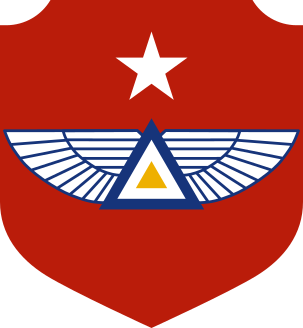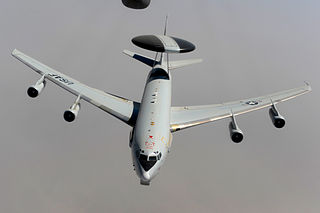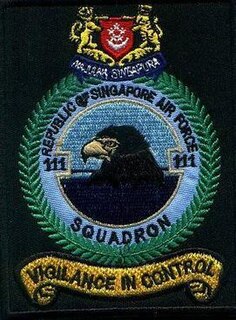
The 122 Squadron of the Israeli Air Force, also known as the Nahshon Squadron (former Dakota Squadron), is a G550 squadron based at Nevatim Airbase. [1]

The 122 Squadron of the Israeli Air Force, also known as the Nahshon Squadron (former Dakota Squadron), is a G550 squadron based at Nevatim Airbase. [1]
The Squadron has six planes with three aircraft used for Airborne early warning and control (CAEW or Conformal Airborne Early Warning, IAI EL/W-2085) and three are used for Signals intelligence (SEMA or Special Electronic Missions Aircraft). [2]
The Squadron formerly operated Douglas DC-3 aircraft until 2000.

The Boeing E-3 Sentry is an American airborne early warning and control (AEW&C) aircraft developed by Boeing. E-3s are commonly known as AWACS. Derived from the Boeing 707 airliner, it provides all-weather surveillance, command, control, and communications, and is used by the United States Air Force, NATO, Royal Air Force, French Air and Space Force, and Royal Saudi Air Force. The E-3 is distinguished by the distinctive rotating radar dome (rotodome) above the fuselage. Production ended in 1992 after 68 aircraft had been built.

The Northrop Grumman E-2 Hawkeye is an American all-weather, carrier-capable tactical airborne early warning (AEW) aircraft. This twin-turboprop aircraft was designed and developed during the late 1950s and early 1960s by the Grumman Aircraft Company for the United States Navy as a replacement for the earlier, piston-engined E-1 Tracer, which was rapidly becoming obsolete. The aircraft's performance has been upgraded with the E-2B and E-2C versions, where most of the changes were made to the radar and radio communications due to advances in electronic integrated circuits and other electronics. The fourth major version of the Hawkeye is the E-2D, which first flew in 2007. The E-2 was the first aircraft designed specifically for its role, as opposed to a modification of an existing airframe, such as the Boeing E-3 Sentry. Variants of the Hawkeye have been in continuous production since 1960, giving it the longest production run of any carrier-based aircraft.

An airborne early warning and control (AEW&C) system is an airborne radar picket system designed to detect aircraft, ships, vehicles, missiles, and other incoming projectiles at long ranges and perform command and control of the battlespace in an air engagement by directing fighter and attack aircraft strikes. AEW&C units are also used to carry out surveillance, including over ground targets and frequently perform C2BM functions similar to an Air Traffic Controller given military command over other forces. When used at altitude, the radar on the aircraft allows the operators to detect and track targets and distinguish between friendly and hostile aircraft much farther away than a similar ground-based radar. Like a ground-based radar, it can be detected by opposing forces, but because of its mobility and extended sensor range, it is much less vulnerable to counter-attacks.

The Gulfstream G550 is a business jet aircraft produced by General Dynamics' Gulfstream Aerospace unit in Savannah, Georgia, US. The certification designation is GV-SP. As of January 2016, there were 450 G550s in service. The final G550 commercially available unit is to be delivered in 2021. A version of the airplane with reduced fuel capacity was marketed as the G500.

The Boeing 737 AEW&C is a twin-engine airborne early warning and control aircraft based on the Boeing 737 Next Generation design. It is lighter than the 707-based Boeing E-3 Sentry, and has a fixed, active electronically scanned array radar antenna instead of a rotating one. It was designed for the Royal Australian Air Force (RAAF) under "Project Wedgetail" and designated E-7A Wedgetail.

The Gulfstream V is a long-range, large business jet aircraft produced by Gulfstream Aerospace, derived from the previous Gulfstream IV. It flies up to Mach 0.885, up to 51,000 feet (16,000 m) and has a 6,500 nmi (12,000 km) range. It typically accommodates four crew and 14 passengers. It first flew on November 28, 1995, and entered service in June 1997. It is used by the US military under the designation C-37A. It is followed by an improved version, the Gulfstream 550.

The Lockheed EC-121 Warning Star was an American Airborne early warning and control radar surveillance aircraft operational in the 1950s in both the United States Navy (USN) and United States Air Force (USAF).

Israel Aerospace Industries or IAI (תע"א) is Israel's major aerospace and aviation manufacturer, producing aerial and astronautic systems for both military and civilian usage. It has 15,000 employees as of 2018. IAI is completely state-owned by the government of Israel.

Carrier Airborne Early Warning Squadron 121 (VAW-121), also known as the "Bluetails", is an Airborne Early Warning (AEW) and Command and control (C2) squadron of the United States Navy, operating the E-2D Hawkeye. Established in 1967, the squadron is based at NAS Norfolk. It is currently assigned to Carrier Air Wing 7 and deploys aboard the aircraft carrier USS Abraham Lincoln.
Nevatim Israeli Air Force Base, also Air Force Base 28, is an Israeli Air Force base located southeast of Be'er Sheva, near moshav Nevatim. It was built as a rough runway in 1947 for the Sherut Avir, the air wing of the Haganah, and was named Malhata after the archaeological site on which it was partly built. It was reopened in 1983 as a new modern airbase with two runways as the result of joint Israeli and US government funding as part of the IAF's redeployment out of its bases in the Sinai after it was returned to Egypt following the Camp David Accords. Since 2003 the base has gradually received more squadrons of F-16s. A third runway was built in the mid-2000s decade as part of a project to accommodate the transfer of military activities previously taking place at Ben Gurion Airport to Nevatim.

The Boeing EC-135 is a retired command and control variant of the Boeing C-135 Stratolifter. During the Cold War, the EC-135 was best known for being modified to perform the Looking Glass mission where one EC-135 was always airborne 24 hours a day to serve as flying command post for the Strategic Air Command in the event of nuclear war. Various other EC-135 aircraft sat on airborne and ground alert throughout the Cold War, with the last EC-135C being retired in 1998. The EC-135N variant served as the tracking aircraft for the Apollo program.

The 28th Air Division is an inactive United States Air Force organization. Its last assignment was with Air Defense Tactical Air Command at Tinker Air Force Base, Oklahoma. It was inactivated on 29 May 1992.

The Myanmar Air Force, known until 1989 as the Burmese Air Force, is the aerial branch of Myanmar's armed forces, the Tatmadaw. The primary mission of the Myanmar Air Force (MAF) since its inception has been to provide transport, logistical, and close air support to the Myanmar Army in counter-insurgency operations. It is mainly used in internal conflicts in Myanmar, and, on a smaller scale, in relief missions, especially after the deadly Cyclone Nargis of May 2008.

Minot Air Force Station [Permanent Installation Number (PIN): 1445; Installation Location Code (ILC): QJVM]) is a closed United States Air Force General Surveillance Radar station. It is located 16.2 miles (26.1 km) south of Minot, North Dakota; on the west side of US Highway 83. It was closed in 1979. A portion of the property was reopened in 1984 as the Minot Communications Site and served until 1997.

The 552d Air Control Wing is an operational wing of the United States Air Force. It has been based at Tinker Air Force Base, Oklahoma since July 1976, operating the Boeing E-3 Sentry. It includes the 552d Operations Group, 552d Maintenance Group, and 552d Air Control Group.

The 111 Squadron "Jaeger" was formed when the Republic of Singapore Air Force acquired four Grumman E-2C Hawkeye Airborne Early Warning aircraft in 1987. Based at Tengah Air Base, its primary function is to perform airborne surveillance and early warning. Other functions include Aircraft Intercept Control, Surface Surveillance, Search and Rescue and Air Traffic Control.

The 962nd Airborne Air Control Squadron, sometimes written as 962d Airborne Air Control Squadron, is part of the 3rd Wing at Elmendorf Air Force Base, Alaska. It operates the E-3 Sentry aircraft conducting airborne command and control missions. The squadron's first predecessor was the 862nd Bombardment Squadron, a heavy bomber unit that saw combat during World War II in the European Theater of Operations, where it participated in the strategic bombing campaign against Germany. Toward the end of the war, the squadron operated fighter aircraft, acting as a scouting force for bomber formations. After V-E Day, the squadron returned the United States and was inactivated.

The 192 Squadron of the Israeli Air Force (IAF), also known as the Daya (Milvus) Squadron, was formed in July 1978 with several E-2 Hawkeye Airborne Early Warning aircraft. The squadron served in a reconnaissance role during the 1982 Lebanon War and in other operations since.

The IAI EL/W-2085 is an airborne early warning and control (AEW&C) multi-band radar system developed by Israel Aerospace Industries (IAI) and Elta Electronics Industries of Israel. Its primary objective is to provide intelligence to maintain air superiority and conduct surveillance. The system is currently in-service with Israel and Singapore, and in the future Italy and the United States.